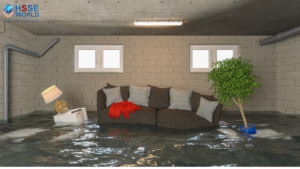Comprehensive Emergency Management
7 min readWhile the functions of emergency management have been performed for decades by government and private organizations (Ben Franklin formed the first fire department more than 200 years ago, for example), it was only recently that the broader ideas about managing emergencies were developed. In this article, the concept used for handling disasters and their consequences is called Comprehensive Emergency Management (CEM). Comprehensive Emergency Management (CEM) is an all-hazards approach attack, natural, and technological to potential threats to life and property. This all-hazards approach results in an increased emphasis on making the nation’s emergency management capability responsive to any major emergency.

emergency management system in the jurisdiction
This expansion into new hazards was not the only change brought about by the development of the concept of Comprehensive Emergency Management, for the concept consists of three interrelated components:
(1) All types of hazards: The commonalities among all types of technological and natural disasters suggest strongly that many of the same management strategies can apply to all such emergencies;
(2) An emergency management partnership: The burden of disaster management, and the resources for it, require a close working partnership among all levels of government (federal, regional, state, county, and local) and the private sector (business and industry, voluntary organizations, and the general public); and (3) An emergency lifecycle: Disasters do not just appear one day. Rather, they exist throughout time and have a lifecycle of occurrence which must be matched by a series of management phases that include strategies to mitigate hazards, prepare for and respond to emergencies, and recover from their effects. Disaster doesn’t just suddenly appear.
A hazard exists, but it takes some event or accident to turn it into a disaster. For example, a river always flows through a town and propane gas trucks pass through the streets. Large amounts of rain or a breaking dam can produce a flood. Equipment failure or human error, similarly, can turn a routine gas delivery into a disaster. As a result, one of the basic principles of CEM is that we can do something useful both before and after a hazard occurs. Comprehensive Emergency Management suggests that there are four phases of emergency management that must work together to protect a community.
Four Phases of Comprehensive Emergency Management
1. MITIGATION – Any activities which actually eliminate or reduce the occurrence of a disaster. It also includes long-term activities that reduce the effects of unavoidable disasters.
2. PREPAREDNESS – Preparedness activities are necessary to the extent that mitigation measures have not, or cannot, prevent disasters. In the preparedness phase, governments, organizations, and individuals develop plans to save lives and minimize disaster damage. Preparedness measures also seek to enhance disaster response operations
3. RESPONSE – Response activities follow an emergency of disaster. Generally, they are designed to provide emergency assistance for casualties. They also seek to reduce the probability of secondary damage and to speed recovery operations
4. RECOVERY – Recovery continues until all systems return to normal or better. Short-term recovery returns vital life support systems to minimum operating standards. Long-term recovery may continue for a number of years after a disaster. Their purpose is to return life to normal, or improved levels.
To accomplish these ends requires a national program built upon local jurisdiction efforts. We will help you begin to acquire the skills and knowledge essential to building a community emergency management program fully integrated into a national emergency management system. IEMS takes into account the fact that each community across the country has its own existing level of emergency management capabilities. Some jurisdictions have already put in place the components of an effective emergency management system.
(Read More: how to keep your team safe during an emergency muster point )
IEMS will build upon these existing capabilities, providing incentives to improve and further integrate localities and states into a national system. In the IEMS approach, the community which has, to this point, done little toward developing emergency management activities will begin a process to develop emergency plans that are governed by national criteria specific enough to provide guidance but sufficiently general to allow flexibility for the local protection options communities believe is critical.
The process begins with a comprehensive hazard assessment prepared by the community, possibly in conjunction with state and federal regional personnel, depending on the circumstances. It then proceeds through an analysis of capability (identifying shortfalls of resources), and moves to the development of generic operations plan with annexes for the emergency management functions and appendices for the unique aspects of individual emergencies, the maintenance of capability, mitigation activities, emergency operations, and evaluation of such operations.
The jurisdiction will then be asked to prepare a multi-year development plan, followed by an annual plan increments as the process proceeds. By following this process, a community can establish an Integrated Emergency Management System with readiness to deal with both the common elements of preparedness and those requirements which are unique to individual emergencies. In jurisdictions that have already developed their planning process more fully, a number of the steps in this process may only need review or update.
In FEMA’s commitment to IEMS rests the commitment to capitalize upon the substantial body of experience in emergency management as well as the vast amount of in-place resources in communities throughout our nation. This course is the first step you, personally, will take toward participating in the national emergency management system. That participation begins, most importantly, in your own jurisdiction as you move toward integrated emergency management. As you proceed with your daily activities, ask yourself how your work relates to public safety from all hazards. Ask yourself how emergency planning can be integrated into overall community planning. And ask yourself how the full partnership of governments and the private sector can be implemented for emergency management.
The community that constantly considers ways to improve emergency management through integration with other resources, skills and knowledge will make significant progress toward improved public safety.
(Read More: whats an efficient way to account for everyone in the event of an on-site emergency )
IEMS and You
The Integrated Emergency Management System provides the broad outlines and some specific tasks of your job.
First, you are responsible for all types of natural and manmade disasters.
Second, your job is to advise and help implement the planning and coordination of, mitigation of, preparedness for, response to, and recovery from all disasters.
Third, you do not act alone in accomplishing emergency management in your jurisdiction.
IEMS is a partnership of other members of your jurisdiction’s staff, the federal, state, and local governments, private business and industry, and the public. Your job, then, includes building and maintaining a partnership that will help fulfill the Integrated Emergency Management System.
The job of the emergency program manager involves all types of disasters, all phases of management, and all necessary participants. In the following chapters you will learn more about the details of the job of an emergency program manager and the vital role you play in protecting the lives and property of your community.
The job of an emergency program manager is that of a public employee acting always in the best interests of your community. When you begin the job, you will be looking at many pieces of a puzzle that, in time, you will learn to put together into an efficient emergency management program. In the beginning, however, there are many parts that you might think fit together loosely. You have heard, for example, that you are charged with establishing systems to help the community survive a drought.
How does this fit, you may wonder, with the floods that happen every year or hazardous materials spills that concern citizens? You also have a job that is specified and defined by law, but you have been hired and can be fired by an elected mayor, or a city manager, or a county executive.
How do the law and your boss fit into your priorities? Then, in addition to legal aspects, you probably find yourself viewing a large part of your job as a moral responsibility to save lives and reduce property damage.
You also may have realized that you are a general without troops. You have been charged with developing emergency plans for the community, but you know quite well that the fire chief has the men and equipment, the Red Cross people handle mass feeding, the public works director has the trucks, the hospital has the medical staff, and the police chief has law enforcement duties. All of these emergency responders come into play in an emergency.
Where do you stand in regard to these emergency operations units? Similarly, where do the next higher levels of government come in? What can you expect from the county, state, or even federal governments? Finally, one of the biggest questions marks right now maybe your job itself. Is emergency program management a new word for civil defense, or is it more? What is the job? What will you have to do? In short, who is this person, the emergency program manager?
(Read More: improving emergency fire response by using technology )



